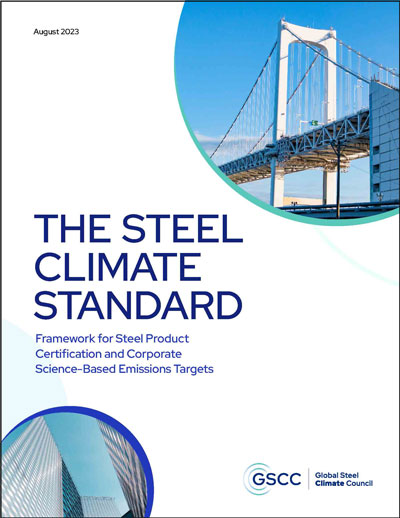Sources: Global Steel Climate Council, Washington, D.C.; Nucor Corp., Charlotte, N.C.; CP staff
A new Global Steel Climate Council standard offers a fair, effective, unbiased tool to measure greenhouse gas (GHG) emissions associated with long products used for concrete reinforcement or tensioning, plus structural steel members or shapes. Along with a protocol behind embodied carbon calculations, the 48-page Steel Climate Standard presents construction stakeholders worldwide steel industry emissions reduction benchmarks through 2050. It mirrors a pathway in the Global Cement and Concrete Association 2050 Net Zero Roadmap, where GHG emissions reduction targets match levels projected to cap 21st century temperature gains at 1.5°C.

GSCC prepared the document around technology-agnostic criteria: Emissions reduction targets apply equally to steel produced in electric arc furnace (scrap feedstocks) or blast furnace or blast oxygen furnace (ore feedstocks) operations. “The Steel Climate Standard measures all steel the same way, no matter where or how it was made,” says Philip Bell, president of the Steel Manufacturers Association (SMA), a founding GSCC member. “That approach makes it easy for steel buyers to determine which steel has the lowest embodied carbon. That’s important because construction firms, governments and other buyers of steel need to know how much embodied carbon is in all the material they use in their own products and projects.”
“This standard was designed through a collaboration of steel companies and associations from around the world,” adds Leon Topalian, chief executive officer of Nucor Corp., SMA member. “It will guide all steel manufacturers worldwide toward decarbonization. It can also guide governments, steel customers and other stakeholders to encourage policies and practices that support this pivotal path to net zero.”
Steel Climate Standard authors use five guiding principles to build a product certification framework: Scientific, Quantitative, Comprehensive, Principled and Transparent. They provide a concise set of criteria for evaluating and certifying steel products as lower-carbon emissions based on their carbon intensity. Much like an Environmental Product Declaration, they establish a system boundary so the document encompasses all GHG compounds from Scope 1, 2 and 3 emissions. They span a steel producer’s Direct (all core processes), Electricity Indirect (power source carbon footprint) and Other Indirect (supplier, supply chain) emissions per the joint World Resources Institute and World Business Council on Sustainable Development GHG Protocol.
In contrast to the GSCC effort, global policymakers are considering a two-part emissions standard, one for steel made from coal and iron ore, the second for material milled from recycled scrap. “Creating a dual standard would allow high-carbon emissions steel to be prioritized over lower carbon steel. This would serve to discourage innovation and allow high-carbon steelmakers to postpone making changes in their production process,” observes GSCC Chair and Nucor General Counsel Greg Murphy.
“No steel should be called clean, green, low-carbon, or responsible if its production generates four or five times as many greenhouse gas emissions as the same steel made by a competitor with a cleaner process,” adds Bell. “Steelmakers whose products have higher carbon intensity will have to change their processes to meet the Steel Climate Standard. And that must happen if we are to meet global emissions reduction goals.”
Related articles
Council opens Steel Climate Standard draft to comments
Steelmakers delineate low vs. high CO2 emissions production methods